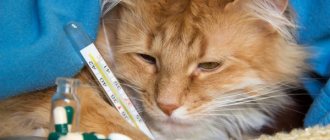Disorders in the nervous system of animals lead to epilepsy. It is believed that epilepsy attacks More often than not, dogs are “attacked,” but veterinarians are increasingly involved in saving representatives of the feline kingdom from such a scourge as epilepsy. Epilepsy in cats manifests itself with many symptoms, such as fainting and convulsions during an exacerbation.
Treatment of this disease should be carried out under the supervision of a veterinarian. The pet owner is entrusted with the mission of caring for the animal; he must also strictly follow the instructions of the attending physician and know the rules of behavior and handling of the cat during a seizure. You can learn about all this from this article.
Description of the disease
Epilepsy in animals is similar to a similar disease in humans.
It appears suddenly: the cat, for no apparent reason, begins to worry, walk or run around the room aimlessly, then the look becomes absent, the animal falls, and begins to convulse. A clear sign is the appearance of white foam in the corners of the mouth, sometimes mixed with blood. The attack lasts no more than 5 minutes, then the animal gradually comes to its senses and returns to normal life. Epilepsy is controlled with medications. The animal will be able to lead a normal life. Regular examination by a doctor is necessary.
Caring for a cat during an attack
When an epileptic seizure occurs, it is necessary to protect the animal from injury during seizures, which may not respond to treatment subsequently.
- The animal's body must not be restrained. The muscles are maximally tense during an attack; restriction of movements can lead to rupture of ligaments and muscles or even fractures of the limbs.
- Turn your head to one side and place a blanket under it. This will prevent impact injuries and the possibility of saliva getting into the lungs.
- Do not put fingers or foreign objects into the mouth. The statement that an animal can develop asphyxia as a result of a recessed tongue is a myth; its muscles are tense, like the rest of the muscles of the whole body. And the introduction of foreign objects or hands into the mouth can lead to broken teeth or injury to a finger when inserted into the mouth.
- Remove any dangerous objects within the radius of the animal having an attack.
Why is epilepsy dangerous?
Epilepsy is a signal that significant negative changes are occurring in the pet’s body.
The main danger of the disease is uncontrolled convulsions, due to which the animal can:
- hit hard;
- bite your tongue;
- start to choke;
- choke on saliva.
If the attack begins on the street, the cat may get hit by a car, fall from a height (for example, from a tree), or be attacked by dogs.
One-time, less often regular seizures are possible. If a cat remains unconscious for a long time, then refuses water and food, becomes very weak, and without proper assistance, there is a possibility of the pet’s death.
Prevention
What should be done for preventive purposes:
- Vaccinate kittens against diseases that can cause epilepsy.
- Protect the animal from contact with poisonous and toxic substances as much as possible. Including chemicals for cleaning the apartment.
- Do not leave your pet unattended.
- It is worth protecting your pet from stressful situations. For example, collisions with a dog.
All this cannot give an absolute guarantee that epilepsy will bypass the cat, but it will help to significantly reduce the risk of developing the disease.
Causes of epilepsy in cats
The cause of congenital epilepsy is not fully understood. It is associated with improper nutrition of the mother cat during pregnancy or aggravated heredity.
Acquired epilepsy in cats occurs as a consequence of previous diseases:
- meningitis;
- peritonitis;
- diabetes;
- encephalitis;
- leukemia;
- heart, kidney, liver diseases;
- serious poisoning.
Sometimes epilepsy becomes a reaction to medications while treating an infection.
The development of the disease is provoked by poor nutrition. When a pet does not receive enough minerals, vitamins, nutrients, and often eats raw fish, the risk of epilepsy increases.
Dynamics of indicators as a criterion for assessing the quality of treatment of epilepsy with anticonvulsants
Anticonvulsants are traditionally used to treat epilepsy. This involves long-term therapy, which can be considered as a compromise between clinical effectiveness, toxicity and cost of treatment. Modern antiepileptic drugs (AEDs) can achieve remission in 65% of cases and reduce the frequency of attacks in 85% [1, 4, 20, 25].
New AEDs that effectively relieve convulsive conditions of various origins are levetiracetam (Keppra) and topiramate (Topamax), which are not yet widely used in neurological practice, although they differ from the first generation AEDs in better tolerability and safety with long-term use [1, 2, 3 , 4, 5, 6, 7, 14, 15].
Keppra is a structural analogue of piracetam [20], which in its properties approaches the optimal pharmacokinetics for AEDs. It is distinguished by high bioavailability when administered orally (90%), with peak concentrations achieved within 1–3 hours. There is no known effect on other drugs, including AEDs in combination treatment. The half-life of the drug is about 8 hours (longer in the central nervous system), which makes it possible to take it twice. Doses of Keppra can vary from 500 to 5000 mg/day (30–40 mg/kg/day) [7, 23, 24, 25].
Topamax is a sulfate-substituted monosaccharide. It blocks voltage-dependent sodium and calcium channels, is rapidly absorbed when taken orally, and peak plasma concentrations are reached within 1–4 hours. Doses of Topamax vary from 50 to 550 mg/day (3–10 mg/kg/day). The average half-life is 21 hours [18, 22].
The purpose of the study was to study the effectiveness of these AEDs in a comparative aspect in the treatment of different types of epilepsy, including as an emergency treatment when previous antiepileptic therapy has lost its effectiveness with the subsequent use of these drugs.
We observed 37 patients (21 men and 16 women) aged from 1 to 35 years suffering from epilepsy. Symptomatic temporofrontal lobe epilepsy (TEFLO) was diagnosed in 22 patients, symptomatic temporolobar epilepsy (TELO) was diagnosed in 15. Of the 37 patients, 14 (37.8%) had previously been operated on for epilepsy, but the effect was questionable [8 , 10]. All patients consulted a doctor due to a sharp increase in seizures, which began to have a serial, in some cases status, course. Before this, patients had been using various AEDs for a long time (carbamazepine, clonazepam, Radedorm, Relanium, Lamictal, valproate). Considering the lack of effect from the listed AEDs, it was decided to use Keppra and Topamax.
All patients were divided into two groups depending on the AED used.
20 patients aged from 1 to 35 years underwent a course of treatment with Keppra (observation group 1). Keppra doses ranged from 500 to 2500 mg (30–50 mg/kg/day) as a single dose. Then patients began to take the drug 2 times a day under the control of clinical and electroencephalographic (EEG) patterns.
Topamax was used in 17 patients aged from 1 to 35 years (2nd observation group). Topamax was prescribed in two doses depending on age and weight, starting from 25 to 50 mg (from 3.0 to 12.5 mg/kg/day); The titration step was 2 days. Doses were selected depending on the dynamics of clinical data and EEG.
Daily clinical examination was carried out for 21 days, then every 15 days for the next 3 months and once every 3 months for the next year. The total follow-up period was 16 months.
Neuropsychological testing was performed. General somatic examination included clinical and biochemical blood tests. Before starting treatment with new AEDs, all patients underwent magnetic resonance imaging and computed tomography using a PHILIPS Gyroscan NT5 (0.5 T) device and a Philips AVE 1 spiral computed tomograph to exclude gross organic brain lesions.
EEG was recorded on a multifunctional complex (Nicolet, basic program Bravo, monitoring program Endeawor). Daily recording was carried out for 10 days, then every 3 days for another 11 days, then every 15 days for the next 3 months, and finally once every 3 months for a year.
We used an ADAS Solus - EPIC gamma camera (Philips), operating in single-photon emission computed tomography (SPECT) mode. In combination with other adequate tests and the patient’s clinical symptoms, this study allows you to collect the necessary diagnostic and prognostic information [9, 13]. Based on the results of SPECT, we determined the effect of Keppra and Topamax on the degree of change in brain tissue perfusion.
Keppra was prescribed in a polytherapy regimen. Before starting treatment with Keppra, patients used the following drugs and their combinations: Depakine, Topamax - 6.6%; depakine, finlepsin - 16.6%; finlepsin, lamictal - 6.6%; depakine chrono - 52%; finlepsin - 13.3%. Taking into account the significant deterioration in the condition of all patients (series of seizures, status epilepticus), while various combinations of AEDs used and increasing their doses did not have any positive effect, we began treatment with Keppra with a “loading dose”. The first dose was 500–1500 mg, on the second day it was increased to 1500–2000 mg in two doses. This strategy differed from that recommended by other authors [7, 14, 23, 24] and was based on such pharmacological data as rapid accumulation (reaching peak serum concentrations within 1–3 hours), long half-life, lack of metabolic activity and influence on other AEDs.
A clinical effect in the form of a reduction in seizures by 43% (p < 0.001) was observed during the first 12 hours in all patients.
On the 3rd day, we began to reduce the dose of previously used AEDs by 1/4 tablet every 3 days.
On the 5th day, 17 out of 20 patients experienced a slight, unreliable increase in seizure frequency, but their number did not reach the initial level (p > 0.05).
During the first 2 days, the patients experienced a change in the quality of seizures, the structure of the attack was simplified: there were no generalized seizures, the duration of the attack decreased. A significant decrease in seizures occurred in the period from the 7th to the 10th day and amounted to an average of 81.87% (p < 0.01). Table 1 presents data on changes in the nature of seizures in patients using Keppra.
To resolve the issue of the effectiveness of valproic acid preparations, a test with intravenous administration of depakine for injection was used [11, 12].
In cases where the ineffectiveness of Depakine was determined, the latter was discontinued at 1/2 tablet of the original dose every 2 days.
As already indicated, treatment began in a polytherapy regimen in combination with the drugs that patients were receiving at the time of treatment, with a gradual reduction in the doses of the original drugs. 17% experienced drowsiness, dizziness, and dyspepsia. In 6 (75%) of 8 children, nervousness and agitation appeared on days 3–5, which regressed over the next 3 days.
When the condition stabilized, the patients took selected medications; the “retention rate” after 8 months of treatment with Keppra was 80%. In cases where patients, due to financial problems, could not receive Keppra for a long time, it was gradually discontinued over 7 days, 1/4 tablet per day. Patients switched back to their original therapy. The condition was stable, but when it worsened, the patients themselves used Keppra in emergency situations, 1000–1500 mg once for 2–3 days.
The selected therapy was not changed for 16 months. The condition remained stable. Status epilepticus and series of seizures were not noted. Keppra is used in emergency mode by 47% of treated patients.
Based on EEG data, 15 (71.4%) patients showed a decrease in the epilepsy index (IE) by an average of 8.57% (p > 0.05). A rapid drop in IE was noted in the first week of therapy, usually on the 3-4th day, less often on the 1-2nd day from the start of drug use, then its stable level and some increase in the 2-3rd week of treatment. When clinical effect was achieved, a stable level of IE was achieved.
In 6 (28.6%) patients receiving Keppra, no diagnostically significant EEG changes were detected.
When analyzing SPECT data by brain zones at the time of exacerbation, an uneven increased accumulation of a perfusion marker in the left temporal lobe was determined: on transverse and frontal sections, areas with increased inclusion of a cerebral blood flow marker in the right superior frontal gyrus were identified (accumulation asymmetry value - 16%), in right parietal-temporal region (asymmetry - 30–35%); in sectoral analysis - with a relative decrease in the area of the inferior frontal gyrus (asymmetry - 11–21%).
10 days after the start of treatment, it was noted that the contours of the left and right hemispheres became relatively symmetrical. The distribution of the perfusion marker is uneven. According to transverse and frontal sections, the maximum asymmetry values were identified in the occipital regions (asymmetry - up to 33%, more on the right), parietal regions (asymmetry - 18–23%, more on the right), in the temporal regions (asymmetry - 14–27%, more on the right ). In the frontal lobes, perfusion was normalized, and asymmetry values did not exceed physiological values.
Topamax was prescribed as a polytherapy regimen. Before the prescription of Topamax, patients took the following combinations of AEDs: Depakine Chrono, Keppra - 6.4%; depakine chrono, finlepsin - 6.4%; finlepsin, lamictal - 9.6%; depakine chrono, lamictal - 6.4%; finlepsin - 9.6%, depakine chrono - 61.2%. To resolve the issue of the effectiveness of valproic acid preparations, a test with intravenous administration of depakine for injection was also used [11, 12]. Taking into account the significant deterioration of the patients’ condition (series of seizures, status epilepticus), and also taking into account that various combinations of AEDs used and increasing their doses did not have any positive effect, we began treatment with Topamax with a “loading dose” against the background of previously administered therapy in emergency mode. The first dose was 25–75 mg (with an average daily dose of 1.5 to 12.5 mg/kg/day), on the second day the dose was increased to 50–100 mg in two doses. This tactic differs from that recommended by other authors [1, 2, 4, 21] and is based on such pharmacological data as rapid accumulation (reaching peak serum concentrations within 1-4 hours), average half-life (21 hours), absence of active metabolites and effects on other AEDs [17, 22].
A clinical effect in the form of a reduction in seizures by 37% (p < 0.001) was observed during the first 24 hours in all patients. On the 3rd day, the doses of previously used AEDs began to be reduced by 1/4 every 3 days.
On the 5th day, 4 of 17 patients experienced a slight, unreliable increase in seizure frequency, but their number did not reach the initial level (p > 0.05).
During the first 2 days, the patients experienced a change in the quality of seizures, the structure of the attack was simplified: generalized seizures were not observed, and the duration of the attack decreased. A significant decrease in seizures occurred in the period from the 7th to the 10th day and amounted to an average of 73.92% (p < 0.01). Table 2 presents data on changes in the frequency of seizures in patients who used Topamax.
A positive effect when prescribing Topamax was noted in 73.92% of cases. The differences in the frequency of seizures before and after treatment turned out to be significant (Table 2) both in groups by age and in groups distributed by the nature of seizures and forms of epilepsy. During the first day, the structure of the paroxysmal attack was reduced: the aura disappeared, headaches decreased.
Unlike Keppra, there were no manifestations of vegetative and psychological discomfort when taking Topamax. Generalized seizures decreased by the 3rd day.
On the 3rd day, the previously used AEDs began to be reduced by 1/4 dose per day, every 3 days. On the 5th day, 10 out of 17 patients showed a slight, unreliable increase in seizures, but their number did not reach the initial level (p > 0.05).
In 10 (58.82%) of 17 patients receiving Topamax, a decrease in IE was recorded by an average of 70–80%. In 4 (23.53%) no diagnostically significant EEG changes were detected. In 3 (17.64%) patients, an increase in IE was recorded by an average of 18–22%.
As for side effects, ataxia, impaired concentration, confusion, and dizziness were noted from the central nervous system and peripheral nervous system, especially during the selection period in the first 2 days. 5 (29.41%) patients experienced a feeling of nausea (successfully relieved with cerucal). Due to the fact that Topamax was primarily used as part of combination therapy, it was difficult to establish the exact cause of side effects.
When analyzing daily EEG recordings, a rapid drop in IE was noted in the first week of treatment (usually this decrease in IE began on the 3rd–4th day, less often on the 1st–2nd day of drug use), then a stable level of IE and a slight increase in IE during 2–3 weeks of use of the drug. When the therapeutic dose was reached, a stable level of IE was achieved, as a rule, significantly lower than before treatment, or it was noted that IE was approaching 0. Such dynamics occurred in 10 (58.82%) patients out of 17. In the absence of a therapeutic effect the stages of changes in IE were smoothed out or were not observed; daily fluctuations in IE were chaotic.
Therapy remained unchanged for 16 months. The condition remained stable. Status epilepticus and series of seizures were not noted.
When analyzing SPECT data by brain area at the time of exacerbation, increased accumulation of a perfusion marker in the temporal, parietal and occipital regions was determined, which indicates the presence of epileptic activity in these areas. 10 days after the start of treatment, it was noted that the contours of the left and right hemispheres became relatively symmetrical. The distribution of the perfusion marker is more uniform. These results confirm the improvement in cerebral perfusion under the influence of Topamax.
A comparison of the effectiveness of Keppra and Topamax revealed that in terms of reducing the frequency of epileptic seizures, the effectiveness of both drugs was almost the same. There was a tendency towards a decrease in the severity of primarily paroxysmal symptoms already in the early stages (up to 7 days). The structure of the paroxysmal syndrome is reduced: the aura disappears, the duration and strength of tonic and clonic convulsions are reduced. The structure of complex paroxysms with psychomotor components is simplified. The duration of attacks is reduced, the post-attack period is also modified: there are no headaches, symptoms of vegetative and psychological discomfort are more easily tolerated (more often when using Topamax), asthenic and vegetative manifestations after major convulsive seizures are reduced and weakened (more often when using Keppra). In a number of patients, post-attack dysthymia and dysphoria are relieved. There was no recurrence of status epilepticus characteristic of generalized forms of epilepsy. Existing mental deviations (dysthymia, dysphoria) and neurotic disorders (depression, hypochondria, overvalued ideas) were regressed.
SPECT data revealed positive dynamics in the form of a more uniform distribution of the cerebral blood flow marker in the brain tissue.
There was no significant distorting effect on the EEG of the drugs Topamax and Keppra. These drugs quickly “sanitize” the EEG. Topamax has a flatter and smoother IE reduction curve, but reduces it more strongly than Keppra. This conclusion requires testing on a larger number of cases.
Positive dynamics of EEG indicators are observed several weeks after using the drugs. A sharp drop in IE in the first 7–10 days after prescription indicates the onset of the drugs’ effect.
For questions regarding literature, please contact the editor.
A. S. Shershever , Doctor of Medical Sciences S. A. Lavrova, A. V. Telegin, A. V. Grib Sverdlovsk Regional Oncology Center, Interregional Neurosurgical Center named after. prof. D. G. Shefer, Ekaterinburg
Symptoms
Pronounced signs of epilepsy are convulsions, a “glassy” look, and abnormal behavior of animals.
Prodormal phase
A harbinger of epilepsy is a sudden change in the cat’s behavior. The animal follows its owner, purrs, rubs against its legs - actively attracts attention to itself. Or he demonstrates disorientation indoors, cannot jump onto high ground, starts screaming loudly - shows severe anxiety.
When there are no obvious causes for the conditions described, it is worth monitoring the pet and not leaving it alone.
The initial stage lasts 5-10 minutes.
Period of convulsions
The cat stops abruptly, its body trembles, salivation begins, and involuntary urination may occur. She does not respond to the owner's voice or any external stimuli. The animal loses consciousness and convulses.
But not all cats have noticeable seizures. Sometimes the animal suddenly freezes, the body takes on an unnatural shape, since all the muscles are tense, but the cat remains conscious. Only the facial muscles can tremble noticeably.
The duration of the attack is up to 3 minutes.
Recovery period
When the acute period passes, the cat's body begins to weaken. The pet does not recognize the owner, is afraid of surrounding traffic, and may show aggression. Sometimes the animal runs to water and food and does not leave the bowls.
Usually the cat’s body recovers in 30-50 minutes.
Symptoms of feline epilepsy
A cat's seizure can be divided into three stages:
Precursor phase. A phenomenon that is quite difficult for humans to grasp. In all cats prone to epileptic seizures, it proceeds in its own way. However, the following symptoms are typical for all: a state of restlessness, lack of response to stimuli, muscle twitching and head tilt to the side. The animal has poor balance.
The convulsions phase is the most severe, it is accompanied by:
- Frequent muscle contractions.
- Intense motor activity of the paws.
- Brief loss of consciousness.
- Release of foamy saliva from the mouth.
- Lack of animal control over the excretory system.
- Difficulty breathing with wheezing.
- Tachycardia.
During the recovery phase, the cat gradually returns to consciousness and motor activity. For about five minutes they may not recognize anyone or anything around them. After this, cats return to normal, and in some cases experience strong feelings of hunger or thirst.
Seizures may occur without pronounced phases. Seizure epileptic states last from three to forty minutes and occur with varying frequency. Seizures that flow from one to another inevitably lead to the death of the pet, since in this case oxygen starvation and changes in the brain begin.
Cats at risk
Although epilepsy can occur in any cat, it most often affects:
- animals with a similar disease in their pedigree;
- kittens whose mothers suffered a serious illness during pregnancy;
- kittens obtained from close relatives;
- survivors of chemical poisoning;
- have had infections, often with complications;
- cats that have been injured or stressed during pregnancy.
There is no age interval for the onset of the disease - seizures occur in kittens and adult cats.
How is cat seizure disorder diagnosed?
The first step in diagnosing a seizure disorder will involve a thorough history from you, and a complete physical examination of your cat. Blood tests will help eliminate some (metabolic) diseases, but more testing on your cat will likely be needed to find the cause. A number of seizure disorders in cats are associated with, often operable, brain tumors.
Diagnostics may include:
- Cerebrospinal fluid analysis;
- Advanced imaging capabilities such as MRI or CT;
- Electrodiagnostics (EEG) (the prerogative of neurology specialists).
Diagnosis of epilepsy in cats
Only a veterinarian can diagnose epilepsy. This requires a long-term comprehensive examination. It requires a lot of strength from the pet and is an additional source of stress. According to experts, it is better to bring your animal for a preventive examination every year and undergo a minimum of mandatory tests. A comprehensive diagnosis of epilepsy should be carried out immediately after an attack.
Based on the results of the examination, the doctor will find out whether epilepsy is congenital or acquired. In the first case, recommendations will be given on how to keep the cat in normal condition, in the second - how to rid it of the disease through complex treatment.
History taking
When making a diagnosis, it is important to fully collect information about the pet:
- pedigree, hereditary diseases;
- previous vaccinations;
- nutritional features;
- medical card;
- a description of the cat’s daily life (are there other animals at home, is he under stress, etc.).
The doctor will definitely ask you to describe in detail the conditions under which the attack occurred, what preceded it, and how quickly the pet recovered.
Cat examination
The examination is carried out by a veterinarian.
First it will check:
- body temperature;
- pressure;
- pulse;
- lung condition (listening with a stethoscope).
The doctor will examine the condition of the fur, open skin, and palpate the abdomen.
Instrumental diagnostic methods
It is advisable that the cat be examined by a veterinary neurologist after an attack. He will do special tests (for example, the reaction to external stimuli is checked - light, sound).
The doctor will prescribe the following measures:
- electronic encephalogram;
- magnetic resonance imaging of the head;
- Ultrasound of the abdominal cavity;
- X-ray – if necessary.
In some cases, the cat will be given anesthesia before the test.
Laboratory diagnostic methods
At the clinic, the cat needs to undergo the following tests:
- general blood test, urine test;
- blood chemistry;
- blood sugar test;
- analysis for hidden infections;
- saliva test – if necessary.
The test results will help rule out diabetes, toxins, and hidden infections in your pet.
Diagnostics
To diagnose the disease, the veterinarian will need all available information: a description of the attacks, what medications the cat took, other diseases, treatment, etc. In addition, a test of the cat’s blood, urine, possibly an ultrasound of the abdominal organs, etc. will be required, depending on the case. .
How is epilepsy treated in cats?
Epilepsy can be cured when it is provoked by another disease or is acquired. Otherwise, the pet will need regular observation in the clinic, a comprehensive examination 1-2 times a year, taking medications, and following a diet.
Cats with epilepsy can live a long time, provided that the owners follow all the doctor’s recommendations and do not neglect treatment.
What to do during a seizure
To avoid the negative consequences of epilepsy, the cat owner needs to be attentive to the pet and monitor any sudden changes in the animal’s behavior.
If you notice that your cat is behaving strangely, stay with it, offer water, and create comfortable conditions.
If you realize your cat is entering the acute phase of a seizure, do the following:
- Open the windows in the room slightly to allow fresh air to enter - this will help avoid breathing problems.
- Stay alone. Too many people nearby will scare your pet. Small children and other animals should be isolated.
- Place the cat on a sofa or blanket spread on the floor. Any safe place without sharp corners will do. It is important that the animal does not hit or fall.
- During convulsions, the cat should lie on its side so as not to choke on its tongue. A person does not need to hold or specifically press on the tongue.
- Do not fix or hold the animal's paws or body. This can scare or anger your pet. Just be there.
- When the attack passes, do not pick up the cat. Place water and food nearby. If the animal wants, it will approach the food. There is no need to lift it and turn it over.
If you have the opportunity, videotape the attack to show your veterinarian. Record the stages of the attack over time, especially the period during which the animal has fully recovered.
When to contact a specialist
It is important to show your pet to a doctor immediately after an attack or the next day.
Typically the cramps last 1-3 minutes. If the attack is prolonged or the cat is very weak, it is better to see a veterinarian as soon as possible.
If attacks occur several times a day, you should consult a doctor immediately. The cat is in danger. Invite a specialist to your home so as not to expose the animal to additional stress due to a change in environment.
Treatment with drugs
Medicine for epilepsy can only be prescribed by a veterinarian. Do not self-medicate, since a preliminary examination before choosing a drug is mandatory.
Congenital epilepsy is treated with anticonvulsant drops or tablets. A prescription will be issued for 1 year after the examination. Then everything depends on the condition of the pet. After 12 months, you will need to take tests again and get tested. If there have been no attacks during this time, the dose of the medication will be reduced. In another 6 months it will most likely be cancelled.
If epilepsy is acquired:
- prescribe treatment for the disease that caused the problem;
- anticonvulsants are prescribed.
Usually, when the root causes go away and seizures do not recur, the medicine is discontinued after six months to a year.
There are cases when drugs are prescribed for life. Therefore, consultation with a veterinarian and constant monitoring of the cat are necessary.
Gluten Free Diet
The plant protein gluten is found in grains that are added to most dry cat and kitten foods. Since these animals are carnivores, gluten is poorly tolerated by their bodies. It interferes with the absorption of beneficial substances and vitamins, so it can provoke epilepsy in animals.
One additional way to get rid of seizures is to give your cat a special veterinary gluten-free or low-gluten food. It is sold in specialized pharmacies and pet stores.
Owners who prefer to give cats natural food should know the principles of a special diet:
- exclude raw, minimize cooked fish;
- exclude cereals (rice, barley, corn);
- diversify your diet with meat (chicken, beef, rabbit);
- Make sure your pet receives vitamins (special vitamin complexes as prescribed by the doctor).
How to treat kittens
Medical practice shows that adult cats are more susceptible to epileptic seizures than kittens. Congenital epilepsy will manifest itself no earlier than six months of age.
First aid for a kitten remains the same as for an adult cat: place it on its side on a soft, stable surface, do not restrict its movements, offer water.
Only a doctor will prescribe drug treatment. These are special anti-convulsant drugs, adapted for kittens, with a reduced dosage. If the kitten’s attacks do not recur, therapy is prescribed when it reaches one year of age.
If the kitten has a history of epilepsy or there is a high risk that it has suffered intrauterine trauma, it is better to feed the pet gluten-free kitten food for prevention. In agreement with the veterinarian, a comprehensive examination is carried out without waiting for the first signs of the disease.
How to stop epilepsy attacks
The appearance of an epileptic attack in a cat is no reason for the owner to panic. We need to get together and provide first aid. The main actions of a cat owner during an attack:
- Laying the animal on a hard surface in a side position. It is advisable to lay something thick and soft to prevent possible head injury during an attack.
- Gently hold the animal's head with your hand, while simultaneously paying attention to changes in saliva (possible appearance of foam or blood impurities). This indicates that the animal has damaged its tongue, lip or buccal mucosa.
- At home, during exacerbation of epilepsy, doctors do not recommend self-treatment with drugs. It is not advisable to try to force a cat to drink.
It is also the owner’s mistake to use force against the animal during an attack. Trying to pin a cat to the floor during an epileptic seizure in an attempt to stop the convulsions will not achieve positive results. A cat can not only bite the owner, but also receive serious injuries. Only a veterinarian after a thorough examination can completely stop attacks or reduce their manifestation to a minimum.
Features of caring for a sick pet
Because epileptic seizures occur suddenly, it is important to protect your sick cat by:
- do not allow sitting on open windows and loggias without supervision;
- do not let one out into the street;
- remove traumatic loose objects from the apartment;
- limit access to tall furniture (cabinets, tables, shelving);
- change your diet smoothly.
Try not to turn on bright lights or loud music in the presence of a cat. Do not play with the animal flashlight and laser pointer. Refrain from using New Year's flashing lights.
It is important to be attentive to changes in your pet’s behavior, not leave it alone for a long time and strictly follow the doctor’s advice, and do not skip taking medications.
Forms of epilepsy
In cats, just like in humans, there are two main forms of epilepsy:
- primary (true/idiopathic);
- secondary.
We’ll talk about the causes and characteristics of each form below.
Primary
Primary or idiopathic epilepsy remains largely a mystery to veterinarians because its true causes cannot be discovered. Thoughts are periodically expressed that this form of epilepsy is inherited, but the gene responsible for seizure activity still remains undiscovered.
The causes of primary epilepsy remain unclear to modern medicine
The most mysterious feature of primary epilepsy is that with this diagnosis, seizures occur against the background of good health. Cats susceptible to primary epileptic seizures often do not suffer from other serious diseases, and blood and cerebrospinal fluid tests show completely normal results.
As a rule, true epilepsy manifests itself at an early age. Some cats begin to periodically suffer from attacks as early as four to five months, which has a very negative effect on the functioning of the brain and the functioning of the fragile body as a whole.
Primary epilepsy is detected in cats at a young age
Secondary
The secondary form of epilepsy is much easier to analyze, since it presupposes the presence of objective factors that provoke repeated attacks. The causes of secondary epilepsy can be either endogenous (caused by disruptions in the functioning of the body) or exogenous (caused by external influences).
Head injuries are a common cause of secondary epilepsy
Among the most common factors that provoke secondary epilepsy, doctors identify the following:
- head injuries resulting in concussion;
- past inflammation of the brain;
- malignant tumors of the brain;
- panleukopenia (distemper);
- congenital abnormalities in the process of GM formation (for example, hydrocephalus);
- hypoxia;
- past infectious diseases of the brain (such as encephalitis or meningitis);
- intoxication (heavy metals).
Cats that survive distemper often experience various complications, including epilepsy.
In some cases, epileptic seizures can cause pathologies that are not directly related to the functioning of the brain, for example, kidney or liver diseases. Sometimes cats exhibit conditions similar to epileptic seizures during severe poisoning, but from a physiological point of view, such seizures are not related to epilepsy and show only an external similarity with it.
Prevention of epilepsy
Only acquired epilepsy can be treated.
Seizures of epilepsy in a cat can be avoided if:
- follow the vaccination schedule;
- carry out deworming;
- Limit your pets' time outdoors to prevent parasite infestation;
- do not allow the animal to come into contact with household chemicals and medicines for people;
- organize proper nutrition;
- Have your pet examined by a veterinarian annually.
Owners of a sick animal need to remember that with properly organized treatment and a life schedule, epilepsy in a cat can be controlled, and in some cases, cured.
Treatment
Once epilepsy in cats has been diagnosed at the veterinary level, the tailed patient must be treated immediately. Healing will require medications that have a positive effect on the cerebral cortex, regulating nervous excitability. This prevents seizures from occurring.
If a young cat experiences seizures no more than once a year, treatment may be limited to following the recommended behavior regimen and a fairly simple diet. If epileptic attacks occur once a month or more often, then the veterinarian prescribes medications in addition to the course of treatment, a vitamin complex and specialist supervision.
Progression of an epileptic attack
The idea of an epileptic attack as a short period of convulsions is naive and deeply erroneous. The structure of an epileptic seizure consists of four main stages that a cat goes through. Only one of these stages occurs during immediate convulsions. The remaining three are not so obvious to an external observer, and therefore in most cases go unnoticed by the owners.
Before a seizure occurs, cats go through several preliminary stages that affect their behavior.
You can often hear from owners of animals with epilepsy that their pet was just sitting on a windowsill or sofa, and then suddenly fell and shook. However, from a physiological point of view, there is no talk of any surprise. The body approaches the attack gradually, which also affects the cat’s well-being. Of course, recognizing these changes is not easy, but if you start to look closely at your animal, then over time you can learn to identify a number of characteristic symptoms that indicate the approach of seizure activity.
Each cat experiences periods of seizure activity differently.
Video - Epilepsy attack in a cat
Structure of an epileptic seizure
So, there are four main stages of an epileptic attack:
- prodromal stage;
- aura;
- ictal stage;
- postictal stage.
Despite the complex terms, it is quite easy to understand all the listed stages. We will talk about each of them further.
Prodromic stage
This stage is preparatory; its duration can vary from a couple of days to several hours. The symptoms at the introductory stage are very vague and individual in nature. Among the manifestations characteristic of the prodromal stage are the following:
- sleep disorders;
- lack of appetite;
- apathy.
When cats enter the prodrome stage, they often lose interest in food.
In some cats, the prodrome stage has no significant symptoms and has little effect on their behavior.
Aura
The aura represents a fine line between the preparatory stage and the immediate entry into a convulsive state. The aura stage is usually much shorter than the prodromal stage. Another difference between an aura and the prodromal stage is the greater severity of symptoms. During the Aura period, owners often notice that their cats become “a little strange,” as if half asleep.
During the Aura, the cat may be either overexcited or drowsy.
You can recognize this condition in your pet by the following signs:
- disturbance of orientation in space, consisting of aimless wandering around the house;
- general state of nervousness, anxiety;
- the need to seek shelter or an obsessive desire to constantly be near the owner in search of support;
- inadequate reaction to interaction - sometimes owners may feel that the cat does not recognize them;
- increased salivation (not always the case).
Shortly before an attack, cats may become unnaturally hostile towards their owner.
Ictal stage
The ictal stage is the actual culmination, during which an epileptic attack occurs. Despite the fact that even the most inexperienced owner can guess the presence of an attack, we will dwell on its main manifestations:
- the animal falls on its side, its body seems to become stone and freezes;
- during an attack, the cat’s chest does not rise, which indicates that breathing has stopped;
- The convulsions themselves occur in different ways. In most cases they resemble running or a series of chaotic jerks;
- the pet's eyes roll back, which is not typical for all attacks. Sometimes the cat lies with an icy, unblinking gaze - in such cases the pupils noticeably dilate.
An epileptic seizure involves intense tension of all muscles
The state of highest tension usually lasts less than a minute, followed by a gradual attenuation of the attack:
- the cat is able to breathe again. The first minutes the breathing is very heavy and fast;
- the animal begins to make active chewing movements with its jaws;
- “running in place” stops, and the pet’s body relaxes;
- gradually the cat begins to blink and move its pupils, which indicates that it will soon come to its senses.
During an attack, the animal can cause significant injury to itself.
The ictal stage has different scenarios. Some cats go through these “circles of hell” once, but in more severe cases, the symptoms described above can be repeated several times. For example, an animal recovering from convulsions again falls on its side and begins to shake. The non-stop onset of new “waves” of seizures is called status epilepticus and poses a serious threat to the life of the pet. You can read more about epistatus in animals below.
Status epilepticus in animals
Postictal stage
One of the main mistakes when treating a pet after a seizure is the assumption that the end of the seizure means the animal’s complete “recovery”. In reality, the fact that the cat is again able to control its body does not mean that it has immediately returned to an “adequate” state.
Recovery from an epileptic seizure takes from several hours to several days for different pets. The strongest painful mobilization of the body does not pass without leaving a trace for any living creature. Therefore, in the days following the attack, it is necessary to show increased attention to your pet and monitor its actions.
After an epileptic seizure, your cat may appear clumsy
Symptoms of the postictal stage depend on the form of its occurrence. In cats, which are characterized by a predominance of excitation over inhibition, the following manifestations are observed:
- state of confusion, loss. An animal may get lost in its own home and begin to panic;
- a state of passion often leads to the fact that the animal avoids contact with the owner or begins to attack him, seeing the person as a threat;
- lack of coordination, which means that the pet may often stumble, fall, or “bump into” obvious obstacles;
- anxiety, frequent jumping up, unmotivated running around the house.
Cats can recover from a seizure without drawing attention to themselves
Those cats in which inhibition dominates often do not differ from healthy ordinary animals, since they do not have such pronounced symptoms as mentioned above. However, less severity does not mean a complete absence of painful manifestations. This group of cats also suffers from disorientation and the effects of brain fog, but does so in a more subtle way.










